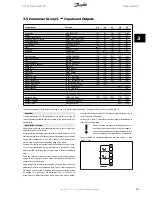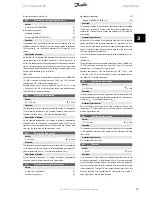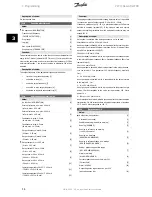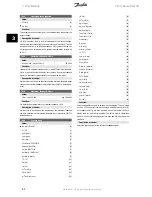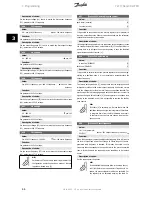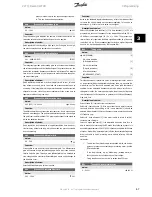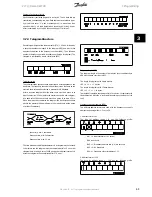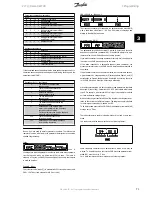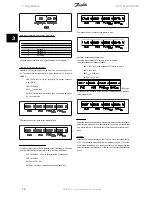
Content of a character (byte)
Each character transferred begins with a start bit. Then 8 data bits are
transferred, corresponding to a byte. Each character is secured via a par-
ity bit, which is set at "1" when it reaches parity (i.e. when there is an
equal number of 1's in the 8 data bits and the parity bit in total). A char-
acter is completed by a stop bit, thus consisting of 11 bits in all.
3.7.3 Telegram Structure
Each telegram begins with a start character (STX) = 02 Hex, followed by
a byte that denotes the length of the telegram (LGE) and a byte that
denotes the address of the frequency converter (ADR). Then follows a
number of data bytes (variable, depending on the type of telegram). The
telegram is completed by a data control byte (BCC).
Telegram timing
The communication speed between a master and a slave depends on the
baud rate. The frequency converter's baud rate must be the same as the
master's baud rate and be selected in parameter 501
Baudrate
.
After a response telegram from the slave, there must be a pause of at
least 2 characters (22 bits) before the master can send a new telegram.
At a baud rate of 9600 baud there must be a pause of at least 2.3 ms.
When the master has completed the telegram, the slave's response time
back to the master will be a maximum of 20 ms, and there will be pause
of at least 2 characters.
Pause time, min: 2 characters
Response time, min: 2 characters
Response time, max: 20 ms
The time between the individual characters in a telegram may not exceed
2 characters and the telegram must be completed within 1.5 x nominal
telegram time. At a baud rate of 9600 baud and a telegram length of 16
bytes the telegram will be completed after 27.5 msec.
Telegram length (LGE)
The telegram length is the number of data bytes plus the address byte
ADR plus the data control byte BCC.
The length of telegrams with 4 data bytes is:
LGE = 4 + 1 + 1 = 6 bytes
The length of telegrams with 12 data bytes is:
LGE = 12 + 1 + 1 = 14 bytes
The length of telegrams containing texts is 10+n bytes. 10 represents the
fixed characters, while the 'n' is variable (depending on the length of the
text).
Frequency converter address (ADR)
Two different address formats are used, with the frequency converter's
address range being either 1-31 or 1-126.
1. Address format 1-31
The byte for address range 1-31 has the following profile:
Bit 7 = 0 (address format 1-31 active)
Bit 6 is not used
Bit 5 = 1: Broadcast, address bits (0-4) are not used
Bit 5 = 0: No Broadcast
Bit 0-4 = Frequency converter address 1-31
2. Address format 1-126
The byte for address range 1 - 126 has the following profile:
VLT® Decentral FCD
3 Programming
MG.04.B8.02 - VLT is a registered Danfoss trademark
69
3
Summary of Contents for VLT Decentral FCD 300
Page 112: ......

